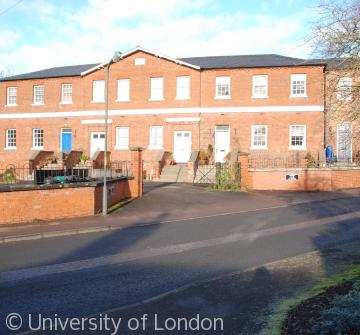Welfare and Poor Relief
 Belle Orchard House, part of the former Ledbury Union Workhouse, built in 1836.
Belle Orchard House, part of the former Ledbury Union Workhouse, built in 1836.In medieval England it was regarded as a religious duty to give alms to the poor, and religious houses (monasteries, nunneries etc) provided shelter, accommodation and food for travellers. The collapse of the monastic system by the sixteenth century left a gap in provision, and with the poor flocking to towns in search of accommodation and work, the government found itself forced to play a role in relief. It did so through a series of statutes culminating in the 1601 poor law legislation, amended in 1660, which provided statutory powers for parishes to raise funds to help to relieve the poor. The parish was given powers to raise a ’rate’, a levy across all the holders of land and buildings in the parish, towards upkeep of the poor. Gradually it added new powers, including in the 1720s the right to provide workhouses. Subsequently powers were given to parishes to combine together to build and staff such premises.
Various alterations in the law followed through the course of the eighteenth century, but the real concern came to be the cost of relief, particularly during the war years between 1793 and 1815, and after much debate, the New Poor Law was introduced by legislation passed in 1834. Parishes were now grouped together into Unions, each with a workhouse, and the poor law was made into a draconian instrument of oppression designed to force the poor into work. Unfortunately the system soon broke down, and workhouses were seldom full; indeed, their most regular clientele tended to be the elderly with no where else to go, mothers with illegitimate children, orphans and people with mental and physical disabilities. The Victorians, aware of the problems of the New Poor Law, threw themselves into philanthropy, and raised funds to distribute to the deserving poor (those considered to be poor through no fault of their own) in their own homes. The Poor Law was not abolished until 1930, but before that time children had been separated out into more appropriate accommodation and the introduction of pensions by the Liberals before the First World War, led eventually to the creation in 1944 of the Welfare State.









